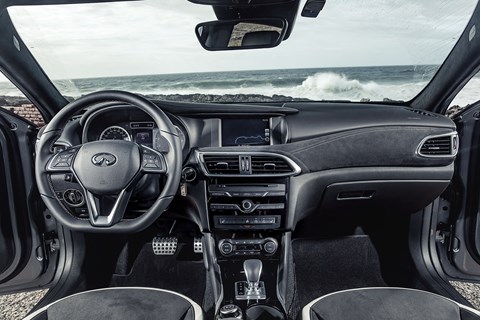► We drive the new Infiniti Q30 hatchback
► Based on the Mercedes A-class platform
► Appealing looks and comfort, not much else
Infinitesimal. That about sums up posh Nissan’s impact on the global car market thus far. Launched in the US in 1989, the same year as Toyota’s Lexus division, Infiniti sold 186,000 in 2014, less than a third of the number of cars of its big Japanese rival, and barely 10% that of Audi. Could the Q30 be the car to change all that?
The market intel certainly suggests it might. Sales are already up 16% this year to date and the premium bit of the C-sector, as currently dominated by the Audi A3, BMW 1-series and Mercedes A-class, is growing rapidly. Even getting a toe-hold with the Sunderland-built Q30 could catapult Infiniti into the mainstream.
To make the project possible Infiniti leveraged its relationship with Mercedes, which offered the transverse-engine platform used in the A-class and GLA. The Q30 comes with a choice of front and four-wheel drive and a mix of Renault-Nissan and Daimler powertrains that kick off with a fleet-spec 107bhp 1.5 diesel and 121bhp 1.6 blown petrol at the lower end of the line-up, and top out with a choice of 208bhp 2.0 petrol and 2.2-litre diesel with 168bhp.
Compared to its rivals, the choice isn’t vast, or fast. In every case the Q30’s straightline performance seems to lag behind the opposition. Eight-five to 62mph in the 168bhp Q30 2.2d? BMW’s 120d does it in 6.8sec and burns less fuel. Benz’s A220CDi – using the same platform and same engine, but tuned to deliver more power than the Q30 can offer – is a whole second quicker and less polluting.
But shine a spotlight on refinement, and the Q30 shines back. A stiff body, long travel suspension and relatively tall tyre sidewalls combine with careful damper tuning to deliver a car that rides significantly better, and cruises far less noisily than the A-class. The big diesel employs active noise-cancelling technology and Infiniti claims the Q30 is 10% quieter than any other car in this sector.
The standard suspension set-up prioritises comfort over handling, but we’d suggest taking the Sport alternative, which means meanie looking bumpers and sidestepping the standard car’s ugly Citroën-like wheels. Not that the Sport’s suspension turns the Q30 into some kind of demon hot hatch – it steers naturally but never feels like a car you want to thrash for the hell of it – but the tangibly tighter body control comes at almost no real cost in ride comfort over sharp intrusions, a feat managed without resorting to an expensive adaptive damper option that few customers will ever buy.
Posh shocks, like fancy safety kit, look good in the brochure, but the reality is punters only like to spend money on stuff they can see. Wheels, paint, personalisation. Baubles, basically. Incorporating that philosophy at a highly efficient factory more accustomed to stamping out thousands of Nissan clones was a challenge, but means you can create some impressively avant-garde combinations of interior colour and trim.
The seats – Infiniti’s own – are excellent but you can’t help but feel slightly disappointed by the interior as a whole. The design below the dash top is plain, and the materials get visibly less pleasant the further down you go. Lined door bins would be nice, as would rotary heating controls that didn’t wobble like a skateboard wheel with a collapsed bearing. And while we’ve no problem with Infiniti using Merc’s switchgear and electronics, the fact that the Merc-sourced digital display between the clear but bland instruments looks nothing like Infiniti’s own main dash display (complete with jerky sat-nav) is a constant reminder of the bitsa origins and undermines Infiniti’s premium image. To be fair, a BMW 1-series cabin is nothing special but you just know that if the public school Toyota team ever jumped into the C-segment, they’d get that stuff right.
So ignore the hype. There’s nothing hugely innovative going on here, but the Q30 has some admirable qualities. It’s the boldest, and arguably the best-looking car in the class, has the biggest boot, cruises quietly and rides well. It’s also significantly better to drive than the Mercedes A-class on which it’s based, and will have exclusivity on its side. We like Audi’s A3 but when there seem to be three on every street your £30k haughty-hatch suddenly doesn’t seem that special. Though flawed, there are flashes of special in the Q30, mostly the way it looks. With only a dozen UK dealers, showrooms and not showroom appeal is going to be Infiniti’s big problem.

Up against
Better than: Audi A3 – To look at
Worse than: Audi A3 – In every other respect
We’d buy: Audi A3 – Boring but brilliant
The specs: Infiniti Q30 Sport 2.2d
On sale: Now
Engine: 2143cc 16v turbodiesel 4-cyl, 168bhp @ 3400-4000rpm, 258lb ft @ 1400-3400rpm
Transmission: Seven-speed dual-clutch, four-wheel drive
Performance: 8.5sec 0-62mph, 134mph, 57.7mpg, 127g/km
Weight: 1598kg
Price: £30,930
Love: The styling – there’s no prettier small hatch
Hate: Dull performance, disappointing cabin quality
Verdict: No rule-breaker, but a nice break from Audi ubiquity
Rating: ****